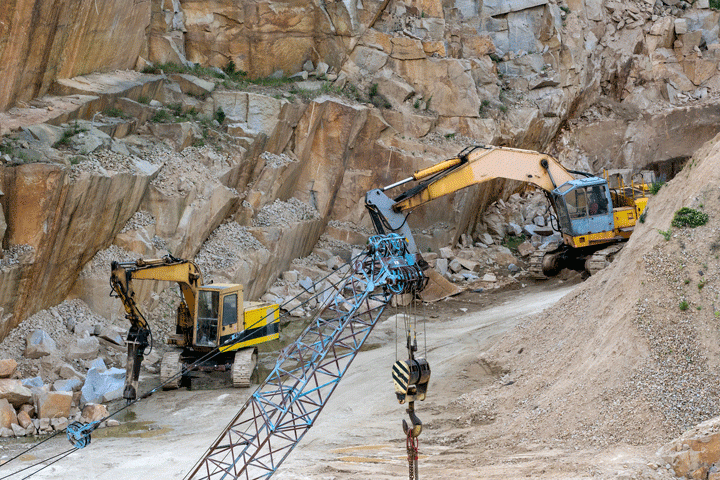Introducing the Mysteries of Granite Quarrying: Where Stamina and Style Meet
The world of granite quarrying is a world where the raw stamina of nature merges with human artistry to produce structures that stand the test of time with an air of sophistication. From the midsts of quarries to the thorough sprucing up in workshops, the process of transforming granite right into architectural wonders is an intricate dance of practice and advancement. As we peer into the depths of this ancient craft, we start to reveal the covert complexities that shape the extremely essence of our developed environment.
The Beginnings of Granite Quarrying
In the record of building history, the beginnings of granite quarrying are shrouded in a tapestry of old craftsmanship and geological marvels. Going back to old Egypt and Mesopotamia, the removal of granite from quarries noted the start of a trip that would ultimately lead to the production of a few of the globe's most famous frameworks.
Granite quarrying's origins can be traced to the skilled craftsmens that identified the rock's sturdiness and visual appeal. With a mix of primitive tools and sheer decision, these early quarry workers discovered granite blocks that would come to be the foundation of human beings.
As people advanced, so did the techniques of quarrying granite. The Romans, renowned for their design prowess, developed advanced techniques for extracting granite to build monuments, holy places, and roads that stood the test of time.
The legacy of these old quarrying practices remains to form modern-day style, with granite remaining an icon of toughness and sophistication in building and construction jobs around the world. (granite quarries in south africa)
Tools of the Quarrying Trade
The evolution of granite quarrying techniques from old civilizations to modern-day times highlights the essential role played by the devices of the quarrying sell forming the market's techniques. In ancient times, quarrying tools were basic, typically containing chisels, hammers, and wedges made from materials like bronze or iron. These devices required significant manpower and time to extract granite blocks from quarries.

Additionally, the introduction of pneumatic tools and high-powered equipment has substantially decreased the physical labor called for in quarrying procedures, boosting employee security and productivity. As the quarrying market address proceeds to introduce, the tools of the trade remain at the leading edge of driving development and forming the future of granite extraction.
Removing Blocks of Granite
Making use of precision equipment and progressed strategies, the extraction of granite obstructs from quarries has actually come to be an innovative procedure in the modern quarrying industry. The initial step involves recognizing the location and dimension of the granite deposit to identify one of the most effective extraction method. Once a suitable site is chosen, the extraction process starts with the boring of holes for the placement of dynamites. Managed blasting methods are after that employed to damage apart the granite right into workable sections.

Sprucing Up and Finishing Strategies
To accomplish a remarkable surface on granite blocks, knowledgeable craftsmens use a collection of careful polishing and ending up methods. After the first removal and shaping procedures, the granite obstructs undertake a thorough polishing stage to enhance their natural elegance and longevity.
In enhancement to polishing, ending up strategies are put on more fine-tune the granite's appearance. These strategies might consist of flaming, honing, or brushing, each offering distinct structures and coatings to suit various aesthetic choices. Flaming, as an example, includes exposing the granite surface area to heats to create a harsh, textured surface, suitable for outside applications where slip-resistance is necessary. Sharpening, on the various other hand, provides a matte surface that is smooth to the touch, perfect for interior kitchen counters and floor covering. By very carefully choosing and applying these brightening and completing techniques, artisans can change raw granite blocks right into beautiful items that display both stamina and beauty.

Environmental Effect and Sustainability
With the growing focus on environmental awareness in the sector, granite quarrying methods are progressively scrutinized for their effect on natural resources and lasting sustainability. Quarrying for granite can have substantial environmental implications. The extraction procedure frequently involves the use of heavy machinery, nitroglycerins, and huge quantities of water, causing habitat destruction, dirt erosion, and water air pollution. In addition, the transportation of granite from quarries to processing facilities generates carbon discharges, further adding to environmental deterioration. granite quarries in south view africa.
To alleviate these influences and guarantee sustainability in granite quarrying, industry stakeholders are adopting various procedures. Applying sophisticated modern technologies to lower power intake and water use, reclaiming quarried land for ecological repair, and advertising liable sourcing practices are some strategies being employed. Qualifications such as the Woodland Stewardship Council (FSC) and the Leadership in Energy and Environmental Layout (LEED) help customers determine environmentally friendly granite products.
Verdict
Finally, granite quarrying is a procedure that needs specialized devices and techniques to extract blocks of granite and brighten them to a high degree of finish. While the environmental influence of quarrying can be considerable, initiatives are being made to boost sustainability techniques in the industry. Overall, granite quarrying is a fragile equilibrium between utilizing the stamina and sophistication of this natural rock while reducing its effect on the atmosphere.